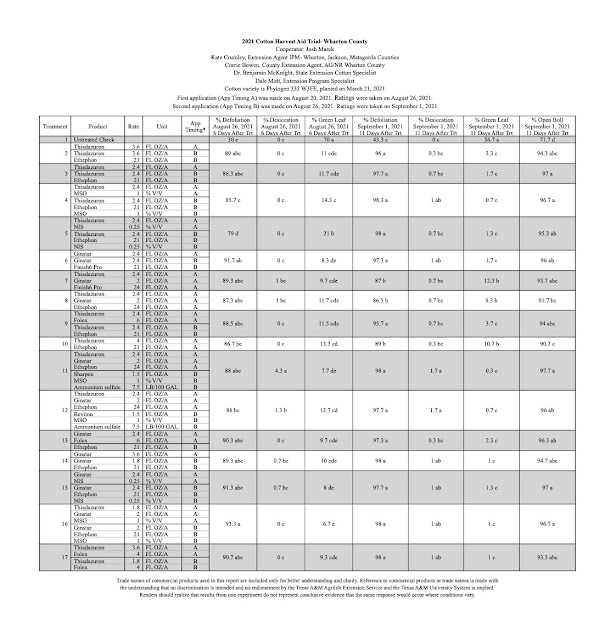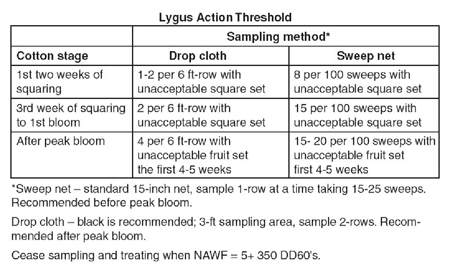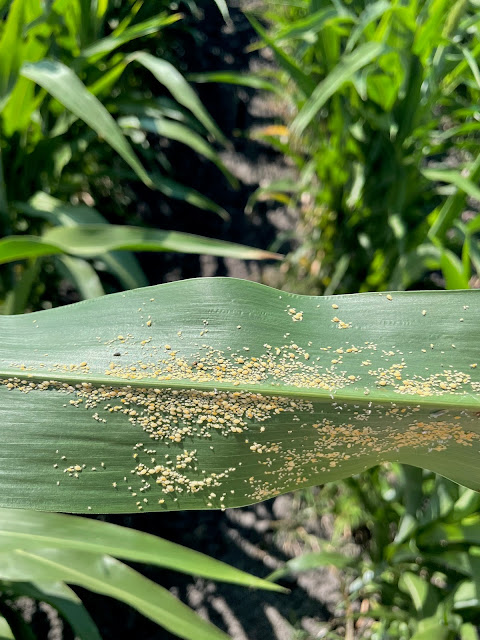Howdy yall,
 |
| Open Cotton in Jackson County Kate Crumley |
We are still seeing a few red banded stink bug around in our soybeans. The economic threshold for redbanded stink bugs in soybeans is 16 stink bugs per 100 sweeps, which is lower than the 36 per 100 sweeps for other stink bug species. Acephate tends to work better on redbanded and brown stink bugs than pyrethroids do. We also need to consider the pre-harvest interval for any fields that may be treated for those. For more information on stink bugs in soybeans check out the Soybean Insect Guide.
 |
| Redbanded Stink Bug in Soybeans Kate Crumley |
Grain harvest is running and a lot of our cotton is being defoliated. There is still a bit of cotton with some growth on the top, but for the most part we are done. Cotton is no longer susceptible to economic damage by plant bugs and bollworms at 350 degree days (DD60), or heat units, past cutout, and is no longer susceptible to economic damage from stink bugs at 450 DD60 past cutout.
 |
| Open Cotton in Jackson County Kate Crumley |
 |
| Kissing Bug found in Matagorda County Kate Crumley |
The 2022 Drought and Alternative Forages for Cattle
By Corrie Bowen
County Extension Agent
Wharton County
Many cattle producers are facing low hay supplies and looking for alternative hay sources and ways to stretch limited supplies. When feeding any non-traditional forage, producers are also curious of the nutritional content of forage. In 2011, during our last significant drought event, I tested these forages for an idea of their nutritional content. Now, 11 years later, I’m referring back to those records as cattlemen are asking the very same questions – What is the nutritional value of these forages? Rice Hay: There’s two types of rice hay: rice chaff hay, which is the chaff that is baled behind the combine; and rice stubble hay, which is what is baled after a hay cutter comes in after the combine, and lays down all of the stubble. Rice chaff hay tended to run 8.9% crude protein, 50 ADF, and 42 TDN. The rice stubble hay ran a little lower in crude protein at 7.8%, 45.1 ADF, and 48 TDN.
Grain Sorghum stubble tends to run 4.8% CP, 60.5 TDN, and 29.4 ADF. Corn stubble hay will be similar to grain sorghum hay, with crude protein ranging from 3-7%, and TDN around 60%. ADF is a laboratory method of determining a fiber fraction that can assist in predicting the digestibility of a feed; lower ADF values tend to be more digestible. Total Digestible Nutrients (TDN) is the sum of the digestible fiber, protein, lipid, and carbohydrate components of a feedstuff or diet. TDN is directly related to digestible energy and is often calculated based on ADF. TDN is useful for beef cow rations that are primarily forage.
Some grain sorghum will regrow following harvest and the first baling of stubble. This regrowth can be very lush, and very high in quality. A sample was submitted from a field where the sorghum grain was harvested, and stalks were flail-mowed. Lush regrowth was cut for hay and the results from the forage tests were: 11.7%CP, 35.4 ADF, 58.3 TDN. Now this type of quality gets closer to meeting the nutritional needs of a lactating cow.
When feeding these low-quality forages, a high-calcium (≥15%), low-phosphorus (≤7.5%) cow-calf mineral should be provided free choice. With rice straw, oxalates then to decrease the absorption of calcium, making calcium supplementation in their free choice mineral an important factor. Because these forages have limited nutritive value they should only be used as the replacement for part of the forage in a ration. They are not intended to be use as complete rations.
But there’s a few more things to know. Grain Sorghum and corn stubble can tie up nitrates. Basically, what happens here is that the plant normally takes up nitrogen from the nitrate form, converts it to ammonium, and then utilizes that ammonium to assimilate amino acids into plant protein. When the plant is under stress, the conversion does not take place and the nitrates accumulate in the stalk. Test results are still coming in, but I have seen one field of corn stubble test high in nitrates this year in Wharton County. Corn stubble is safe to feed to cattle with a nitrate test that is less than 1.0%. Stubble that tests between 1% and 1.5% can be safely fed to cattle if supplement fed with grain.
Sorghum grasses like Grain sorghum, Johnsongrass, Sudangrass, Haygrazers, and Sorghum Alum also produce prussic acid when the plant is under stress (a freeze, saturated soils, or drought can all induce stress in sorghum plants). Prussic Acid, when present in sorghum plants, and when ingested can form hydrocyanic acid in the rumen of a cow. This can be extremely lethal to cattle. Prussic acid in sorghums will dissipate through the curing process, and over time in the bale.
When sampling standing corn or grain sorghum stubble for grazing or hay, sample approximately 15 plants at random throughout the field. Cut the bottom 8 inches of the stalk for nitrate testing. For prussic acid the leaves are collected from the stalks and placed in a zip lock bag. Prussic acid samples must be sent over night for next day delivery. Nitrate samples are not time sensitive, but the nitrate test can take 3 days to complete. If sampling from a bale of forage, the prussic acid sample must be placed in a mason jar and sampled using a forage probe. The Wharton County Extension Office has a forage probe – give us call at 979-532-3310, if we can help. The Texas Veterinary Medical Diagnostic Lab conducts tests on nitrates and prussic acid in forages. You can find the sample forms and testing information at https://tvmdl.tamu.edu/
The AgriLife Soil, Water and Forage Testing Laboratory in College Station conduct nitrates tests in forages and plant tissues. More information on the nitrate test from the Soil, Water, and Forage lab can be found at http://soiltesting.tamu.edu
What is the value of the nutrients removed from the field when stubble is baled? Well, with current fertilizer prices, it’s more valuable. For a baseline reference I state from prior Extension research on what is removed from fields when the crop residue is removed. For every 40 bu/ac of corn, approximately one ton of residue is produced. Each ton of corn residue contains 17 lb N, 4 lb P2O5, 34 lb K, and 3 lb S. This is similar for grain sorghum. For rice hay, each ton of rice residue contains 14.5 lbs N, 1.9 lbs P, and 32.7 lbs K. Please Pray for Rain!
-30-
Sincerely,
Kate Crumley
Check out our weekly IPM Audio Updates
Cotton Insect Management Guide
Development and Growth Monitoring of the Cotton Plant































